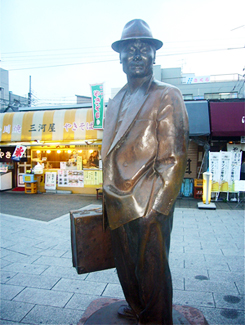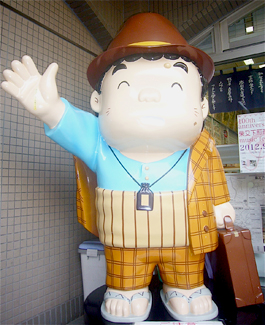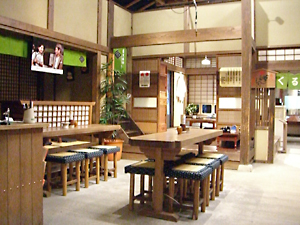 |
|
 |
| Two rather different renderings of Tora-san: (left) an almost dashing likeness in front of Shibamata station, and (right) a cartoony photo-op effigy at the Tora-san Museum. Photos by Alan Gleason |
Rarely has a locality benefited so much from a fictitious resident. But the epic film series Otoko wa Tsurai yo ("It's Tough Being a Man"), which ran to a Guinness record-setting 48 installments between 1969 and 1995, brought fame to the sleepy Tokyo suburb of Shibamata in its guise as the home of the franchise's hero, Torajiro Kuruma, a.k.a. Tora-san.
To be fair to Shibamata, it was already known for Taishakuten, a Buddhist temple founded in 1629 that boasts some exquisite wooden carvings on its massive gate. Back in the days of the Shogunate the temple was a solid day's walk from downtown Edo, but its location on the bucolic banks of the Edo River, the eastern boundary of Tokyo today, made it a popular excursion destination. The shopping street leading to the Taishakuten gate is still thronged on weekends, but the big draw in town is Tora-san, whose devotees make their pilgrimage to a museum dedicated to the Otoko wa Tsurai yo series and its protagonist.
Tora-san and his family were the entirely fictive creation of screenwriter-director Yoji Yamada, who wrote and directed nearly all of the 48 films. Yamada had no particular affiliation with Shibamata and is said to have settled on it as the site of the Tora-san saga only after an exhaustive search of other candidate locations around Tokyo. In any event the neighborhood proved to be the perfect setting for the Kuruma family's dumpling shop, Kuruma-ya. Since much of the franchise's charm stems from its nostalgic evocation of family life in a simpler time -- the postwar Showa era of the 1950s and 1960s -- it is easy to see why Yamada would become enamored of the slow-paced, small-town charm of Taishakuten and its environs.
Tora-san's fans are legion, and the Katsushika Shibamata Tora-san Museum endeavors to show and tell everything anyone could possibly want to know about him, his co-characters, and the films themselves, from plots to props. Opened in 1997 and operated by Katsushika Ward, the museum offers a cornucopia of posters of all 48 films, a making-of video featuring interviews with director and cast, a bank of video screens from which visitors can select scenes from their favorite installments, a large mockup of the Taishakuten temple gate, and a room-size model of the shopping street as it appeared in the Showa days, with every shop replicated in meticulous detail. The centerpiece is the actual set of the Kuruma-ya dumpling shop, transplanted intact from the Shochiku Ofuna Studio south of Tokyo where all the films were made.
But the real focus of the museum is Tora-san himself, a bumbling but good-hearted everyman whose goofy charm has proved to have universal appeal, earning him fans not only in Japan but overseas as well. Torajiro Kuruma is a traveling salesman whose wares vary from film to film -- in one he is peddling cheap toys, in others it's fortune-telling paraphernalia or duck whistles. His earthly possessions fit into a huge leather suitcase that he lugs everywhere. One of the museum's most amusing displays is the suitcase itself, opened to reveal such essentials as a deck of cards, a folding fan, a roll of toilet paper, mosquito-repellent incense, and a monstrous alarm clock that seems to take up half the compartment.
 |
|
 |
| The museum entrance. A model of the Taishakuten gate can be seen inside. Tora-san appears here, too, as the handyman putting up the sign at upper right. Photo courtesy of the Tora-san Museum |
|
The original set for Kuruma-ya, the shop where much of the Tora-san film action occurs, relocated from Stage 9 at Shochiku's Ofuna Studio. Photo courtesy of the Tora-san Museum |
Every film in the series opens as Tora-san returns from his wanderings to his Shibamata home, where his half-sister, aunt and uncle run the dumpling shop. Some sort of family spat soon erupts, however, and Tora-san storms out to hit the road again. In some remote part of Japan he meets a local damsel in distress and falls hopelessly in love, but inevitably fails to get the girl. He is last seen ambling on down the road, suitcase in hand, a bit crestfallen but eternally optimistic. The cycle repeats in the next installment.
One of the draws of the series was the procession of ingenues who played the "madonnas," as these unrequited love interests were called. And indeed, an entire section of the museum is devoted to biographies and film clips of the actresses, many of whom went on to become stars in their own right. But the success of the franchise hinged on the talents of the man who played Tora-san in every one of the films, Kiyoshi Atsumi. So utterly typecast was Atsumi that, as he ruefully acknowledges in the museum's making-of video, he got tired of being treated by strangers as a hot-headed simpleton like the character he played. It is, in fact, a bit jarring to see Atsumi on-screen as himself, a remarkably soft-spoken, articulate, intelligent man.
So completely was Atsumi identified with Tora-san that when the actor died in 1996 at age 68, Yamada, the director, decided to end the series then and there at number 48, which had been released the year before.
Atsumi, in his Tora-san persona, pops up everywhere in Shibamata. Upon leaving the local train station one is greeted by a life-size bronze statue of the character in casual pose, fedora on his head and suitcase in hand. At the museum, a huge, puffy, plastic Tora-san stands ready for photo opportunities, with several other of the character's sartorial trademarks prominently displayed -- his garish yellow-plaid suit, snakeskin sandals, elastic belly-warmer, and the good-luck amulet (from Taishakuten, of course) around his neck.
Shochiku, the film company that owns the rights to the Tora-san franchise, is averse, it turns out, to permitting the display of Atsumi's visage on sites like this one, but you can see a typical Tora-san movie poster and read a thorough exegesis of the film series on the Wikipedia page for
Otoko wa Tsurai yo.
Shibamata is worth a full afternoon's excursion -- not only to take in the Tora-san Museum, but also to enjoy Yamamoto-tei, the lovingly preserved Taisho-era mansion and garden next door (a perfect spot for a cup of tea after the museum), and the Taishakuten temple and shopping district just down the street. For an added treat, take the Yagiri-no-Watashi ferry across the Edo River and back. This is a hand-rowed boat that has been carrying passengers since the Edo era, and it figures largely in the Tora-san films. The pier is just a few minutes' walk from the museum.
 |
| A room-size model of the shopping street leading to the gate of Taishakuten temple, as it looked in the 1960s. Photo courtesy of the Tora-san Museum |
|